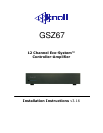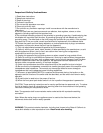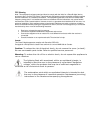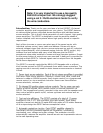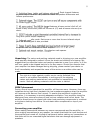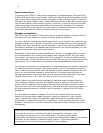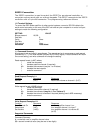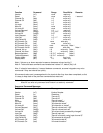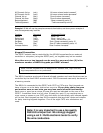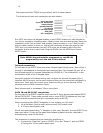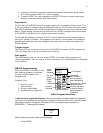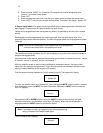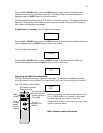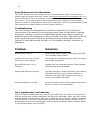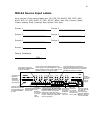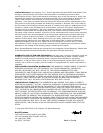
6
Input connections
Connecting the GSZ67 to your source equipment is straightforward. Using the high-
quality RCA audio interconnect cables, match the output channel designations on the
rear of your source equipment to the input jacks on the rear panel of your amplifier
that have the same channel name. When making connections with RCA type plugs on
interconnect cables, make certain to gently, but firmly, insert the plug into the jack.
Loose connections can cause intermittent sound and may damage your speakers.
Some quality RCA plugs may be very tight, and it is important to secure a proper
connection between the interconnection cable and the input jack.
Speaker connections
The GSZ67 has six stereo 50 watts per channel amplified outputs. Channels 5 and 6
also have line level outputs to connect to larger powered amplifiers.
To ensure that the high quality signals produced by your amplifier are carried to your
speakers without loss of clarity or resolution, Knoll advises that you use high-quality
speaker wire. Many brands of wire are available — the choice may be influenced by
the distance between your speakers and the amplifier, the type of speakers you use,
personal preferences, along with other factors.
Regardless of the brand or type of speaker wire chosen, we suggest that you use a
wire constructed of fine, multi-strand copper with a gauge of 16 or less (the lower
the number, the thicker the cable). Wire with a gauge of 16 may be used for short
runs of less than 12 feet. We do not recommend that you use any wires with an AWG
equivalent of 18 or higher due to the power loss and degradation in performance.
To connect the amplifiers to your speakers, a removable plug with screws is provided
for each stereo channel output. Strip approximately 1/4 inch of insulation from the
end of each wire and carefully twist the strands of each conductor together. Be sure
not to cut the individual strands or twist them off. All strands must be used for
optimal performance. Insert the wire into the plug and screw the screws very tight.
Inspect that no wire “hairs” that can short circuit are not in the plug.
Correct polarity connections are important to maintain proper speaker phasing.
When speaker phasing is correct, all speakers move in and out at the same time
preserving the imaging of the program material. Out-of-phase connections mean
that some turn off, check your speakers to verify that they are operating properly. If
all other potential sources of trouble check out properly, contact Knoll for further
assistance.
Run the cables to speaker locations. Do not coil any excess cable, as this may
become an inductor that creates frequency response variations in your system.
Lastly, connect the wires to the speakers, again being aware of proper polarity.
Remember to connect the negative, or black wire, to the matching terminal on the
speaker. The positive, or red wire should be connected to the matching terminal on
the speaker.
Note: While most speaker manufacturers follow industry convention of using red
terminals for positive connections and black terminals for negative, some
manufacturers may vary from this configuration. To ensure proper phase
connections, and optimal performance, consult the identification plate on our speaker
terminals, or the speaker’s manual to verify polarity. Contact the speaker’s
manufacturer if you do not know the polarity of your speakers.



